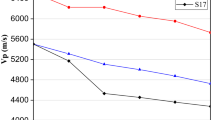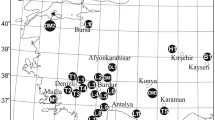Abstract
Freeze-thaw is one of the most powerful weathering agents that may cause a rapid change in the mechanical properties of stones, and thus limit their durability. Consequently, determining the mechanical properties of stones after freeze-thaw is important to select the natural building stones for outdoor applications, which are exposed excessive freeze-thaw cycles. The purpose of this study is propose statistical models for predicting the mechanical properties of travertine building stones after freeze-thaw test. For this, 12 travertine samples were selected and their physical and mechanical properties including density (ρ), water absorption (Wa), uniaxial compressive strength (UCS), and P-wave velocity (VP) were determined. Then, freeze-thaw test up to 60 cycles was carried out and mechanical properties including the UCS and VP of the samples were measured. Using data analysis, statistical models for predicting the mechanical properties of deteriorated samples after freeze-thaw test were proposed. In these models, the mechanical property of samples after freeze-thaw was considered to be the dependent variable–dependent on the independent variables of the initial mechanical property of the samples and their water absorption. The results show that statistical models are in good accuracy for predicting the mechanical properties of samples, and thus a rapid durability assessment.
Access provided by Autonomous University of Puebla. Download conference paper PDF
Similar content being viewed by others
Keywords
1 Introduction
Travertine is a chemical sedimentary rock formed mostly in tectonic areas (Pentecost 2005). Nowadays travertine with different color, texture and pattern are widely used as building materials for construction and decoration purposes especially for outdoor applications such as flooring, paving and wall cladding.
Freeze-thaw action is one of the most powerful physical weathering agents, which may cause a rapid change in the mechanical properties of travertines, and limit their durability. Therefore, the resistance to deterioration (durability) should be evaluated before the selection of an appropriate building stone (Zappia et al. 1998).
Uniaxial compressive strength (UCS), and P-wave velocity (VP), are one of the most important mechanical properties to assess stones durability against weathering agents (Zezza 1990; Valdeon et al. 1996; Goudie 1999; Nicholson 2001; Benavente et al. 2004). However, change in the mechanical properties of stones due to weathering agents can affect their durability in the course of time (Jamshidi et al. 2013). Thus it is necessary to understand the change of mechanical properties of stones when freeze-thaw is considered as one of the weathering agents.
The aim of this study is propose the statistical models for predicting the mechanical properties (UCS and VP), of 12 travertine building stones after freeze-thaw test. In these models, the mechanical property of stones after freeze-thaw was considered to be the dependent variable–dependent on the independent variables of the initial mechanical property of the stones and their water absorption.
2 Materials and Methods
To carry out the research, 12 travertine building stones were selected from various quarries in Iran (Fig. 83.1). For each travertine, some of block that varied from 0.2 × 0.35 × 0.35 to 0.30 × 0.40 × 0.40 m in size were collected. The physical and mechanical properties including density, water absorption, uniaxial compressive strength and P-wave velocity of each sample were determined. Freeze-thaw test up to 60 cycles was carried out and mechanical properties of samples after treatment were measured. Using data analysis, statistical models for predicting the mechanical properties of samples after freeze-thaw test were proposed.
3 Physical Properties
To fulfill the aim of the study, some of physical properties of the samples including density (ρ) and water absorption (Wa) were determined in accordance with ISRM (1981). The results of these tests are given in Table 83.1. According to the rocks classification based on ρ suggested by Anon (1979), most of the samples were classified as to have moderate ρ (2.2–2.55 g/cm3).
4 Freeze-Thaw Test
For freeze-thaw test, initially, the samples were saturated by submerging in tap water and then placing in a freezer conditioned at −12 °C for 12 h. After removing the samples, they were thawed by placing in a water bath at 12 °C for 12 h. Each complete cycle of freeze–thaw lasted for 24 h, comprising 12 h for freezing and 12 h for thawing and the test procedure was repeated for 60 cycles.
Two series of samples were prepared for each stone type to identify their UCS and VP before and after the treatment. The first series were utilized for determination of fresh stone properties (initial properties) and the second series were subjected to freeze-thaw cycles. After 60 cycles of freeze-thaw, for UCS and VP, the measurements were made on five specimens under saturated conditions. The experimental procedure was performed according to the methods suggested by the ISRM (1981). The results of freeze-thaw test on the samples are given in Table 83.2.
5 Statistical Analysis of Results
In this study, the multivariate regression equations were used for predicting the mechanical properties of the deteriorated samples. In these equations, the mechanical properties of samples after 60 cycles of freeze-thaw test were considered to be the dependent variable, which dependent on the independent variables of the initial mechanical properties of the samples and their Wa. Multivariate regression equations were undertaken with 95 % confidence level and the best-fit curves were obtained using the least squares method. Coefficient of multiple determinations (R2) and standard error of estimate (SEE) were used as the numerical measures of the goodness of fit for regression equations.
The general model for predicting the mechanical property after freeze-thaw test is expressed in the following form:
where M60 is the predicted value of the mechanical property (UCS or VP) for the samples after 60 cycles of freeze-thaw test, M0 is the fresh mechanical property or, in other words, the initial mechanical property (initial UCS0 or VP0), Wa is the Wa of the fresh sample, α0 is a constant, α1 and α2 are the regression coefficient of M0 and Wa, respectively.
The data given in Tables 83.1 and 83.2 were analyzed using Spss® v.16 code statistical software. The results of these analyses are given in Table 83.3.
The R2 of equations of E1and E2 given in Table 83.3 is higher than 0.978 that is at acceptable level. The SEE values for equations of E1 and E2 is 1.63 and 59.25, respectively. These measures show that equations can be accepted as a highly reliable for predicting the mechanical properties after freeze-thaw with the coefficients given in Table 83.3.
To test the global usefulness and the significance of equations, analysis of variance for the regressions were also performed. F statistics test is widely used in regression and analysis of variance. The null hypothesis for this test is H 0: α 1 = α 2 = 0, against alternative hypothesis H 1: at least one of α 1, α 2 is not equal to zero. Analysis of variance for the regressions is given Table 83.3. For a significance level of 5 %, the tabulated F-ratio with degree of freedom υ1 = 2 and υ2 = 9 is 4.26. Since all the computed F-ratios for the equations are quite larger than tabulated F-ratio, the null hypothesis is rejected. So, it can be concluded that the equations given in Table 83.3 are appropriate for predicting the mechanical properties of samples after freeze-thaw test.
The relationship between the measured the mechanical properties and estimated values from equations given in Table 83.3 using 1:1 slope line is shown in Figs. 83.2 and 83.3. A point lying on the line indicates an exact estimation. The Figs. 83.2 and 83.3 indicate that the data points fall close to the 1:1 slope line and are scattered uniformly around it, suggesting that equations with the suggested coefficients are appropriate for predicting the mechanical properties after freeze-thaw test.
Measured UCS versus estimated UCS from Eq. (E1) given in Table 83.3
Measured VP versus estimated VP from Eq. (E2) given in Table 83.3
6 Conclusions
The freeze-thaw test is a well-known test for mechanical properties and durability assessment of building stones and construction materials. However, performing freeze-thaw test is a very laborious and time-consuming. In this paper, statistical models for predicting the UCS and VP of 12 travertine samples after freeze-thaw were proposed.
The results show that statistical models are in good accuracy for predicting the UCS and VP, and thus a rapid durability assessment. As a result, these models avoiding from performing freeze-thaw test, which is laborious and time-consuming.
However, it must be pointed out that travertine are notoriously variable and heterogeneous in their properties such as mechanical properties and porosity due to the nature of its porous media. As a result, these models can be used with care for rocks with the range of initial properties (fresh properties) of samples studied here.
References
Anon OH (1979) Classification of rocks and soils for engineering geological mapping. Part 1: rock and soil materials. Bull Assoc Eng Geol 19:355–371
Benavente D, García del Cura MA, Fort R, Ordonez S (2004) Durability estimation of porous building stones from pore structure and strength. Eng Geol 74:113–127
Goudie AS (1999) Experimental salt weathering of limestone in relation to rock properties. Earth Surf Process Land 24:715–724
ISRM (1981) Rock characterization testing and monitoring. In: Brown ET (ed) ISRM suggested methods. Pergamon Press, Oxford, pp 211
Jamshidi A, Nikudel MR, Khamehchiyan M (2013) Predicting the long-term durability of building stones against freeze-thaw using a decay function model. Cold Reg Sci Technol 92:29–36
Nicholson D (2001) Pore properties as indicators of breakdown mechanisms in experimentally weathered limestone. Earth Surf Process Land 26:819–838
Pentecost A (2005) Travertine. Springer, Berlin
Valdeon L, de Freitas MH, King MS (1996) Assessment of the quality of building stones using signal processing procedures. Q J Eng Geol 29:299–308
Zappia G, Sabbioni C, Riontino C, Gobbi G, Favoni O (1998) Exposure tests of building materials in urban atmosphere. Sci Total Environ 224:235–244
Zezza U (1990) Physical–mechanical properties of quarry and building stones. In: Veniale F and Zezza U (eds) Advanced workshop; analytical methodologies for investigation of damage stones. Pavia, pp 1–20
Author information
Authors and Affiliations
Corresponding author
Editor information
Editors and Affiliations
Rights and permissions
Copyright information
© 2015 Springer International Publishing Switzerland
About this paper
Cite this paper
Jamshidi, A., Nikudel, M.R., Khamehchiyan, M., Zalooli, A. (2015). Statistical Models for Predicting the Mechanical Properties of Travertine Building Stones After Freeze-Thaw Cycles. In: Lollino, G., Giordan, D., Marunteanu, C., Christaras, B., Yoshinori, I., Margottini, C. (eds) Engineering Geology for Society and Territory - Volume 8. Springer, Cham. https://doi.org/10.1007/978-3-319-09408-3_83
Download citation
DOI: https://doi.org/10.1007/978-3-319-09408-3_83
Published:
Publisher Name: Springer, Cham
Print ISBN: 978-3-319-09407-6
Online ISBN: 978-3-319-09408-3
eBook Packages: Earth and Environmental ScienceEarth and Environmental Science (R0)







